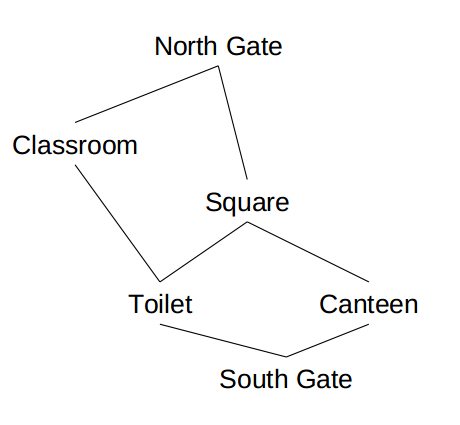利用廣度優先遍歷(BFS)計算最短路徑
阿新 • • 發佈:2019-01-26
我們用字串代表圖的頂點(vertax),來模擬學校中Classroom, Square, Toilet, Canteen, South Gate, North Gate幾個地點,然後計算任意兩點之間的最短路徑。
如,我想從North Gate去Canteen, 程式的輸出結果應為:
BFS: From [North Gate] to [Canteen]:
North Gate
Square
Canteen首先定義一個演算法介面Algorithm:
public interface Algorithm {
/**
* 執行演算法
*/ 然後,定義圖:
/**
* (無向)圖
*/
public class Graph {
// 圖的起點
private String firstVertax;
// 鄰接表
private Map<String, List<String>> adj = new HashMap<>();
// 遍歷演算法 這裡我們使用策略設計模式,將演算法與Graph類分離,通過在構造Graph物件時傳入一個Algorithm介面的實現來為Graph選擇遍歷演算法。
public Graph(Algorithm algorithm) {
this.algorithm = algorithm;
}無向圖的儲存結構為鄰接表,這裡用一個Map表示鄰接表,map的key是學校地點(String),value是一個與該地點相連通的地點表(List<String>)。
// 鄰接表
private Map<String, List<String>> adj = new HashMap<>();然後,編寫Algorithm介面的BFS實現:
/**
* 封裝BFS演算法
*/
public class BroadFristSearchAlgorithm implements Algorithm {
// 儲存已經訪問過的地點
private List<String> visitedVertex;
// 儲存最短路徑
private Map<String, String> path;
@Override
public void perform(Graph g, String sourceVertex) {
if (null == visitedVertex) {
visitedVertex = new ArrayList<>();
}
if (null == path) {
path = new HashMap<>();
}
BFS(g, sourceVertex);
}
@Override
public Map<String, String> getPath() {
return path;
}
private void BFS(Graph g, String sourceVertex) {
Queue<String> queue = new LinkedList<>();
// 標記起點
visitedVertex.add(sourceVertex);
// 起點入列
queue.add(sourceVertex);
while (false == queue.isEmpty()) {
String ver = queue.poll();
List<String> toBeVisitedVertex = g.getAdj().get(ver);
for (String v : toBeVisitedVertex) {
if (false == visitedVertex.contains(v)) {
visitedVertex.add(v);
path.put(v, ver);
queue.add(v);
}
}
}
}
}其中,path是Map型別,意為從 value 到 key 的一條路徑。
BFS演算法描述:
1. 將起點標記為已訪問並放入佇列。
2. 從佇列中取出一個頂點,得到與該頂點相通的所有頂點。
3. 遍歷這些頂點,先判斷頂點是否已被訪問過,如果否,標記該點為已訪問,記錄當前路徑,並將當前頂點入列。
4. 重複2、3,直到佇列為空。
測試用例:
String[] vertex = {"North Gate", "South Gate", "Classroom", "Square", "Toilet", "Canteen"};
Edge[] edges = {
new Edge("North Gate", "Classroom"),
new Edge("North Gate", "Square"),
new Edge("Classroom", "Toilet"),
new Edge("Square", "Toilet"),
new Edge("Square", "Canteen"),
new Edge("Toilet", "South Gate"),
new Edge("Toilet", "South Gate"),
};@Test
public void testBFS() {
Graph g = new Graph(new BroadFristSearchAlgorithm());
addVertex(g);
addEdge(g);
g.done();
Stack<String> result = g.findPathTo("Canteen");
System.out.println("BFS: From [North Gate] to [Canteen]:");
while (!result.isEmpty()) {
System.out.println(result.pop());
}
}
